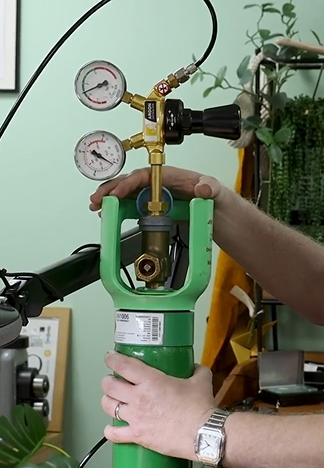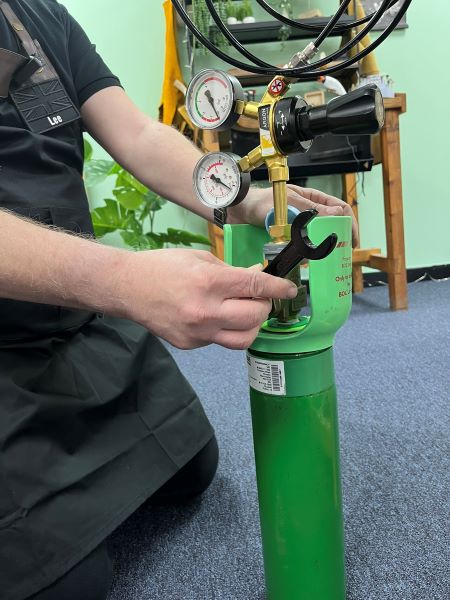When setting up a permanent jewellery welder, like the LG Findings, permanent jewellery welder, argon gas plays a vital role in getting strong, clean results. If you’re new to this, we are here to provide all the essential information and answer any FAQs you may have.
To help you feel confident and ready to get welding, we asked our expert Lee to walk us through the top five most common questions about argon gas and how to use it with your welding setup.
1. What Are the Different Elements of the Argon Gas Bottle?
When your argon bottle arrives from your gas supplier, it will come with a sealed cap you’ll need to remove before use. On the bottle itself, you’ll find:
- The main valve – This is where you turn the gas on and off.
- The regulator connection – Where your regulator screws on.
- Pressure gauges – These show you the amount of gas in the bottle and the output pressure.
- Adjustment knob – Used to set your desired pressure level.
- Hose connection – This is where the main hose connects and leads to your welder.
Understanding these parts will make setup much easier and ensure safe operation.

2. How Do You Set the Pressure of the Gas Bottle?
Setting the pressure is simple:
- Place the regulator onto the bottle and screw it on securely.
- Use a wrench to tighten the connection firmly.
- Turn the main valve on using the handle.
- Adjust the pressure using the knob on the regulator
3. What’s the Perfect Pressure to Use?
The ideal gas flow for permanent jewellery welding is 2 litres per minute, which you’ll find at the beginning of the green zone on your regulator gauge. This pressure is perfect for creating a clean, controlled welding environment.

4. What Tools are Needed to Adjust the Gas Pressure?
The best tool for the job is a multipurpose wrench that fits both the gas bottle valve and the regulator. It makes opening and closing the bottle easy, and it’s the right size for removing or securing the regulator.

5. How Does Argon Gas Improve Your Welds?
Argon gas acts as a protective shield around the welding area. This shield prevents oxidisation while you weld, which means:
- Cleaner, smoother welds
- Stronger bonds
- Professional-looking finishes
To see the difference, compare a weld without argon, which would often be dull and rough, to one with argon, which is noticeably cleaner and more refined. Exactly what you need with permanent jewellery.

Using argon gas with your PUK TIG welder is one of the easiest ways to improve your results. With a little knowledge and the right tools, it’s a smooth and safe process that will help elevate your jewellery making setup.

Sian Brown
Sian has been hand making her award winning jewellery in the West Midlands for over 12 years. Sian spent 10 years in Birmingham’s historic Jewellery Quarter before relocating to a quiet Worcestershire village.

